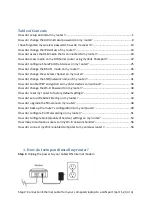
77
●
microSD / microSDHC
— A small, removable flash memory card available in various storage sizes.
Some products have a slot that allows them to utilize this external memory.
●
Network Operator
— The vendor who provides your wireless access. Known by different names in
different regions, some examples are: wireless provider, network provider, and service provider.
●
Network Technology
— The technology on which a particular network provider’s system is built; such
as GSM, HSPA, CDMA, EDGE, and EVDO.
●
Port
— A virtual data connection used by programs to exchange data. It is the endpoint in a logical
connection. The port is specified by the port number.
●
Port Forwarding
— A process that allows remote devices to connect to a specific computer within a
private LAN.
●
Port Number
— A 16-bit number used by the TCP and UDP protocols to direct traffic on a TCP/IP
host. Certain port numbers are standard for common applications.
●
Protocol
— A standard that enables connection, communication, and data transfer between
computing endpoints.
●
PUK code
(Pin Unlock Key) — A PUK is required when you enter an incorrect PIN 3 times. After
entering the wrong PIN 3 times, the SIM card is disabled.
●
Rev A
— CDMA EV-DO Rev. A is a leading-edge wireless technology with higher data rates and higher
system capacity. It is a fully backward compatible standard and remains interoperable with deployed
EV-DO networks and devices around the world. The increased data rates on Rev. A’s physical layer
enable richer applications and services. For more information, visit
www.cdg.org
.
●
Router
— A device that directs traffic from one network to another.
●
SIM
— Subscriber Identification Module. Found in GSM network technology, the SIM is a card
containing identification information for the subscriber and their account. The SIM card can be moved
to different devices.
●
SSID
— Service Set IDentifier. The name assigned to a Wi-Fi network.
●
TCP
— Transmission Control Protocol. A core protocol for transmitting and receiving information over
the Internet.
●
TCP/IP
— Transmission Control Protocol/Internet Protocol. The set of communications protocols used
for the Internet and other similar networks.
●
UI
— User Interface. The part of a software application or hardware device that a user sees and
interacts with.
●
UMTS
— Universal Mobile Telecommunications Service. A third-generation broadband, packet-based
transmission of text, digitized voice, video and multimedia at data rates up to 2 Mbps. UMTS offers
a consistent set of services to mobile users all over the world. UMTS is based on the GSM standard.
Until UMTS is fully implemented, users can use multi-mode devices that switch to currently available
technology.
●
USB
— Universal Serial Bus. A connection type for computing device peripherals such as a printer,
mobile modem, etc. USB connectors may be used for data transfer or charging.
●
VPN
— Virtual Private Network. A secure private network that runs over the public Internet.
Commonly used to connect to an office network from elsewhere.
Содержание MiFi 3352
Страница 1: ...Intelligent Mobile Hotspot 3352 3372 ...
Страница 24: ...Setting Up a Temporary Hotspot Using a microSDHC Card With Your MiFi Device Using MiFi and Sharing Files 2 ...
Страница 64: ...Overview Common Problems and Solutions Using the Master Reset Button Troubleshooting 4 ...
Страница 79: ...Glossary 6 ...


































